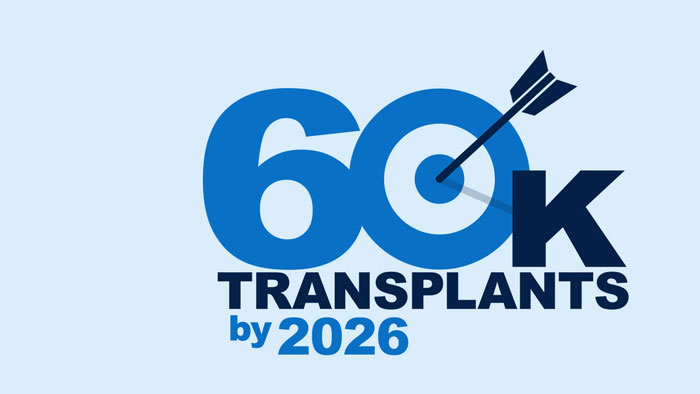The OPTN Expeditious Task Force embarks on ambitious project to save more lives, increase efficiency
Today, the OPTN Expeditious Task Force announced a bold goal of achieving 60,000 successful, lifesaving deceased donor transplants annually in the U.S. by the end of 2026. That number represents a 58% increase in deceased donor transplants over the next three years.
The task force was created by the OPTN Board of Directors in September 2023 to pursue accelerated change across the nation’s organ donation and transplantation system, increase the number of lifesaving transplants by tackling the industry’s biggest challenges of organ non-use and allocation out-of-sequence and improve the deceased donor allocation process. Membership includes transplant patients, patient and donor family members, organ donation and transplant clinicians, community advocates and others. Twenty percent of task force members have no prior affiliation with the OPTN.
“As the task force name implies, we need to move quicker, be more responsive, and deliver results for the patients we serve,” said Dianne LaPointe Rudow, DNP, president of the OPTN Board of Directors. “The reality is that while the number of transplants continues to grow, so does the non-use of available organs and allocations of organs out of the intended sequence of offers. Increasing transplantation to meet this bold aim is certainly a challenge. But we believe it is achievable with shared commitment to innovation and improvement in the organ allocation and placement process. Of course, any approach to boost the number of transplants must also uphold our commitment to provide all patients the best and most equitable access to receiving a transplant.”
The task force set the goal of 60,000 transplants by 2026 by identifying the top 20 percent of transplant programs by growth in transplant volume across the country. Their growth trajectory and studies of other successful improvement initiatives, such as the US Organ Donation Breakthrough Collaborative, informed the bold goal. Learning from effective practices and recommendations from the donation and transplant community, the task force intends to recommend multiple rapid, small-scale trials of innovative approaches to increase organ usage and placement efficiency.
The need is clear. In the case of kidneys, the most transplanted organ, the number of kidneys recovered from deceased donors increased by 56 percent between 2018 to 2023. Yet the number of kidney transplants only increased by 44 percent, meaning that approximately one quarter of kidneys recovered were not transplanted.
George Surratt, a member of the OPTN Board of Directors and a patient representative serving on the Expeditious Task Force, recognizes the effort as an opportunity to drive important changes.
“We have the chance with this task force to make a real difference for patients,” Surratt said. “I’ve been the person waiting for that call from my doctor letting me know that an organ was available; that call is life-changing. So I’m excited that our work here today and going forward will ensure that more patients receive that all-important call, and that the gifts of generous donors save even more lives. My fellow task force members and I are here with open minds, a willingness to embrace new approaches, and an understanding that the nation’s patients are the driving force behind this effort. It’s an exciting and inspiring time to be engaged in this work.”
Under a proposed variance for expedited placement, currently out for public comment, the task force intends to develop a series of rapid, small-scale tests of innovative organ placement approaches and assess their outcomes to evaluate whether they could be incorporated into future OPTN policies. The task force also has committed to prioritizing studies that evaluate potential frameworks for allocating hard-to-place organs to increase the number of transplants and lower non-use rates.
The Health Resources and Services Administration (HRSA) supports the task force’s work, and both HRSA and the Scientific Registry of Transplant Recipients (SRTR) contractor continue to provide feedback and ideas to shape the aims and approaches the task force is considering.
The task force has reviewed evidence-based recommendations from many sources, including the National Academies of Sciences, Engineering, and Medicine’s (NASEM) 2022 report and the work of the OPTN Ad Hoc Committee on Systems Performance. It also received input from a variety of stakeholders, including patients, donor families, advocates, medical professionals and transplant leaders. As the task force develops actionable recommendations for new initiatives, it will engage with transplant professionals, patients and the public to participate in the projects and provide feedback to guide additional work.

